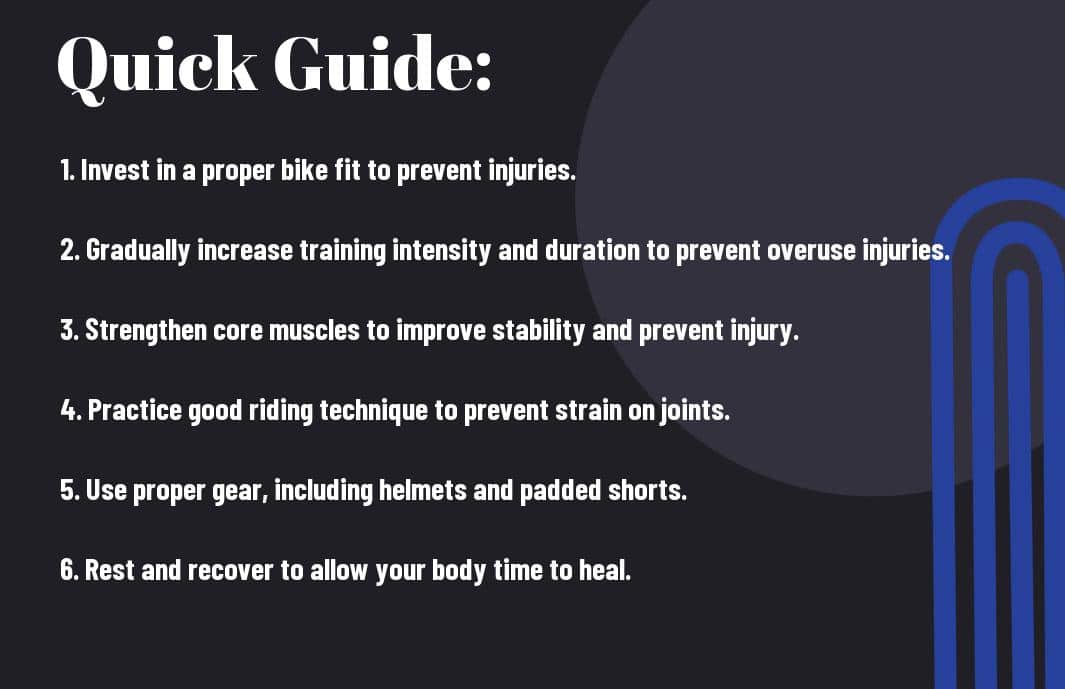There’s no denying the incredible physical benefits of cycling, but as with any sport, injuries can happen. Whether you’re a seasoned cyclist or just starting out, preventing and treating cycling injuries is necessary to ensure you stay on the road pain-free. In this comprehensive guide, we will cover key tips on how to avoid common cycling injuries, effective stretching and strengthening exercises to keep your body in top shape, and expert advice on how to recover from injuries should they occur. Stay tuned to learn how to enjoy the thrill of cycling while keeping injuries at bay!
Key Takeaways:
- Proper Bike Fit: Ensuring your bike is properly fitted to your body can help prevent common injuries like knee pain or back strain.
- Gradual Increase in Intensity: Progressing slowly in your workouts can help avoid overuse injuries such as tendonitis.
- Strength Training: Incorporating strength training exercises can improve muscle imbalances and enhance overall performance while reducing the risk of injuries.
- Stretching and Flexibility: Regular stretching can increase flexibility, reduce muscle tightness, and prevent injuries related to stiffness.
- Proper Nutrition and Hydration: Staying hydrated and fueling your body with the right nutrients are vital in preventing fatigue and enhancing recovery.
- Regular Rest and Recovery: Giving your body adequate time to rest and recover is important in preventing overtraining injuries and maintaining optimal performance.
- Seek Professional Help: Consult with a sports medicine specialist or physical therapist for any persistent pain or discomfort to prevent long-term injuries.
Understanding Cycling Injuries
If you are an avid cyclist or planning to take up cycling as a regular activity, understanding common cycling injuries and their prevention is crucial. Cycling injuries can range from minor aches and pains to more serious issues that can hinder your cycling experience and overall well-being.
Types of Cycling Injuries
If you want to enjoy cycling without the fear of injuries, it is imperative to familiarize yourself with the common types of cycling injuries. Some common cycling injuries include:
- Lower back pain
- Patellofemoral pain syndrome (knee pain)
- Saddle sores
- IT band syndrome
- Fractures
Knowing these injuries and their symptoms can help you take preventive measures and seek timely treatment if needed.
| Lower back pain | Most common in long-distance cyclists, improper bike fit and poor posture can contribute to this issue. |
| Patellofemoral pain syndrome | Also known as runner’s knee, this condition can occur in cyclists due to improper bike setup or overuse. |
| Saddle sores | Caused by friction and pressure on the buttocks, maintaining good hygiene and proper cycling shorts can prevent this discomfort. |
| IT band syndrome | Tightness or inflammation of the IT band can lead to knee pain, proper stretching and strengthening exercises can help alleviate the issue. |
| Fractures | Resulting from accidents and falls, wearing protective gear and practicing safe riding habits can reduce the risk of fractures. |
Knowing the signs and risk factors associated with these cycling injuries is imperative for maintaining your cycling health and performance.
Factors Contributing to Cycling Injuries
One of the key aspects in preventing cycling injuries is understanding the various factors that contribute to them. Some factors contributing to cycling injuries include:
- Improper bike fit
- Overtraining
- Poor technique
- Environmental conditions
- Ignoring pain signals
Perceiving these factors and making necessary adjustments can significantly reduce your risk of injury.
Understanding the impact of improper bike fit, overtraining, poor technique, environmental conditions, and ignoring pain signals on your cycling performance and well-being is crucial in preventing injuries. By acknowledging these factors and taking proactive measures, you can enjoy a safer and more fulfilling cycling experience.
Prevention Strategies for Cyclists
Step-by-Step Guide to Proper Equipment Setup
Not setting up your cycling equipment properly can lead to discomfort and even injuries. To ensure a safe and efficient ride, follow this step-by-step guide to proper equipment setup:
| Equipment | Proper Setup |
| Saddle | Adjust height to allow a slight bend in the knee at the bottom of the pedal stroke. |
| Handlebars | Position at a height that allows a slight bend in the elbows for comfort and control. |
| Pedals | Ensure proper alignment and cleat adjustment for efficient power transfer. |
Tips for Safe Cycling Practices
Safe cycling practices are important to prevent accidents and injuries on the road. Follow these tips to ensure a safe ride:
- Wear a helmet: Protect your head in case of falls or collisions.
- Obey traffic rules: Follow traffic signals and signs to stay safe on the road.
- Use hand signals: Indicate your intentions to drivers and other cyclists for better communication.
Perceiving your surroundings and staying alert can help you anticipate and avoid potential dangers on the road.
The importance of proper equipment setup and safe cycling practices cannot be overstated. By following these guidelines, cyclists can significantly reduce the risk of injuries and enjoy a safe and fulfilling riding experience.
Treatment Approaches for Cycling Injuries
Immediate Response to Cycling Injuries
For immediate responses to cycling injuries, it is crucial to assess the situation and address any potential dangers. Start by ensuring the safety of the injured cyclist and those around them. Check for any life-threatening injuries and administer first aid if necessary. It is vital to immobilize the injured area and seek medical attention promptly. Be mindful of, quick and appropriate actions can make a significant difference in the outcome of the injury.
Long-Term Recovery and Rehabilitation
Recovery from cycling injuries often requires a comprehensive approach that includes rest, physical therapy, and possibly surgery in severe cases. Physical therapy plays a crucial role in restoring strength, flexibility, and mobility in the affected areas. It is imperative to follow the rehabilitation plan provided by healthcare professionals diligently. Additionally, making necessary adjustments to bike fit, equipment, and training routines can help prevent recurrent injuries.
Response
In terms of long-term recovery and rehabilitation from cycling injuries, consistency and patience are key. It is imperative to allow the body enough time to heal properly and rebuild strength gradually. Working closely with healthcare providers, such as physical therapists and sports medicine specialists, can help ensure a successful recovery process. Be mindful of, prioritizing your health and well-being is paramount in returning to the saddle safely.
Maximizing Performance and Safety
Pros and Cons of Protective Gear
After a long ride, your body might feel the wear and tear of the road. Using protective gear can help prevent injuries and keep you safe on your bike. However, there are both pros and cons to consider when it comes to using protective gear.
| Pros | Cons |
| Prevent injuries | Can be bulky and uncomfortable |
| Provide added protection | May limit mobility |
| Boost confidence | Costly to invest in quality gear |
Balancing Training and Recovery
Even the most seasoned cyclists need to find a balance between training and recovery to maximize their performance and prevent injuries. Pushing too hard without giving your body time to rest can lead to overuse injuries and burnout.
Recovery is just as important as training when it comes to improving your cycling performance. Make sure to incorporate rest days into your training schedule, listen to your body, and prioritize proper nutrition and hydration. By finding the right balance between training and recovery, you can improve your cycling performance and stay injury-free.
Conclusion
With this in mind, it is crucial for cyclists to be proactive in preventing and treating injuries. By implementing proper bike fit, incorporating strength training, maintaining flexibility, working on proper form, and listening to your body, cyclists can reduce the risk of injuries and keep enjoying their rides to the fullest. Recall, prevention is key, but if injuries do occur, seeking professional help and following a structured rehabilitation plan will help you get back on your bike in no time. Stay safe, be mindful of your body, and keep riding!
FAQ
Q: What are the most common cycling injuries?
A: The most common cycling injuries include knee pain, lower back pain, saddle sores, and wrist pain. These injuries can be caused by poor bike fit, improper technique, overtraining, or muscle imbalances.
Q: How can I prevent cycling injuries?
A: To prevent cycling injuries, make sure your bike is properly fitted to your body measurements. Also, gradually increase your mileage to avoid overtraining, cross-train to strengthen supporting muscles, and maintain good cycling form. Additionally, listen to your body and rest when needed.
Q: What are the treatment options for cycling injuries?
A: Treatment for cycling injuries can include rest, ice, compression, elevation (RICE), stretching and strengthening exercises, physical therapy, and in severe cases, surgery. It is important to consult with a healthcare professional for an accurate diagnosis and personalized treatment plan.




